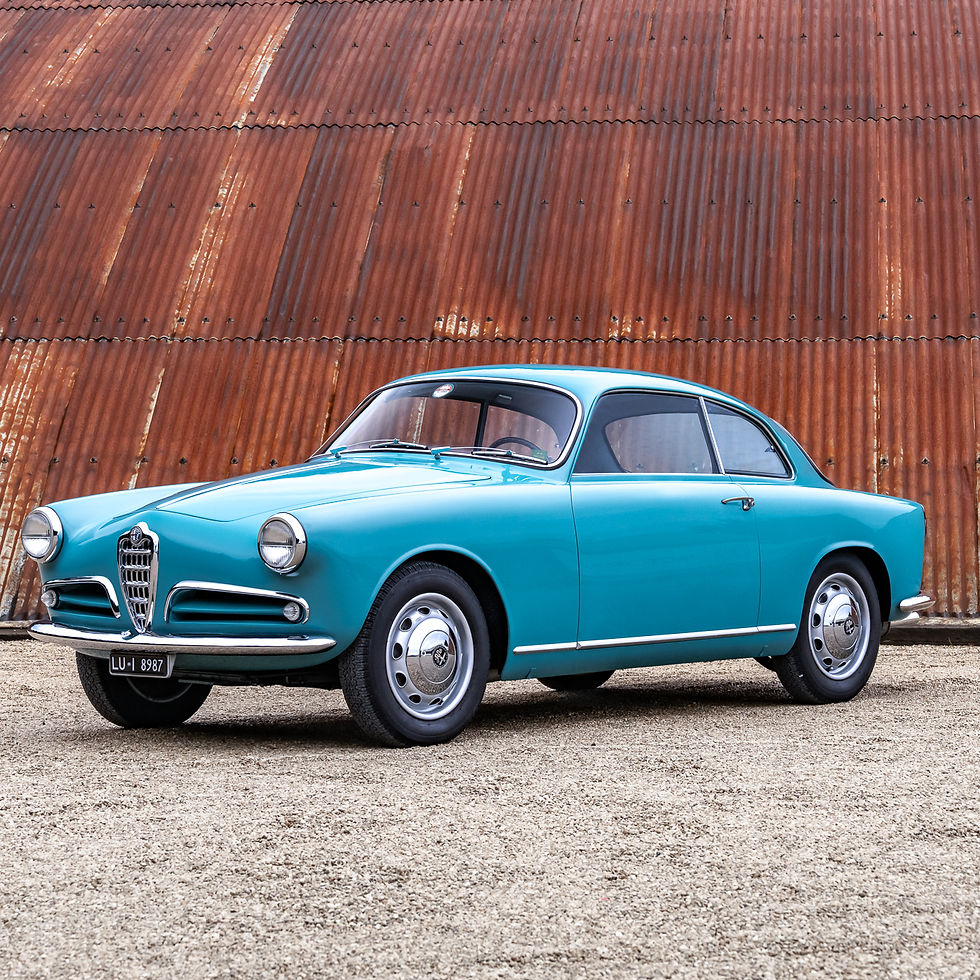What is the sporty version of a sports sedan? To a race car, that goes without saying. That's exactly what the Giulia Ti Super is, which takes the qualities of the 1900 Ti Super to the extreme by pushing the concept to the extreme: lightweight bodywork, a vitamin engine, a more rigid low-profile chassis and 189 km/h top speed. Built to only 501 units over two years, the most desired - and falsified! - of Giulia is nowadays extremely rare. We have found one of the authentic copies still in circulation. It is under its Italian name, Quadrifoglio, that ti super will be universally known. Paraphrasing what Heny Ford said about the Model T: the Giulia Ti Super was delivered in any color, as long as it was white. Of the 501 units produced, only two had another shade: *595135* red, and *595416* grey. It is necessary to immerse oneself in the nomenclature of the Alfa Romeo of the Glorious Thirty to better understand the specificity of this car. If the term "Super" refers to a rich version and "Ti" (Turismo internazionale) to a sporty one, what is the meaning of "Ti Super"? A luxury model with a doped engine? Lost! Lost! In this case, "Super" does not indicate a level of finish, but reinforces the sporty side suggested by the acronym Ti. A "super sports car" in short. The 1900, whose Super had 90 hp and the Ti 100 and Ti Super 115 hp, had already been designed in this way. At the launch of the Giulia on 27 June 1962, Alfa Romeo understood that it had a very interesting asset to highlight the idea of the "family sedan that wins races", a slogan that had accompanied, not without success, the release of the 1900. More powerful than the Giulietta, much more agile than the 2600 6-cylinder, which indirectly took over from the 1900, the Giulia is designed to seduce with its original and aerodynamic design well ahead of a competition that, at best, is inspired by the Americans, like Fiat and its 1300/1500. On April 24, 1963, Alfa Romeo added spice to its recipe by unveiling the Ti Super on the Monza racetrack.
Its engine is more or less identical to that of the Giulia SS, the 1.6-litre version of the old Giulietta SS designed and produced by Bertone. Despite a slightly different power supply, it will deliver the same power as the coupé, 113 hp, compared to the Giulia Ti's 90. Designed for a truly sporty clientele that intends to engage it in competition more than for eager bourgeoisie, the newcomer takes back the four-leaf clover that brought luck to the racing Alfa Romeo in the 1920s. In order to support a relatively large increase in power, detailed modifications cause the car to lose about 100 kg. Two AV headlights were removed - the central torque having been replaced by a grille -, the Campagnolo alloy wheels, and the bumpers got rid of their bananas. The interior, revised by Zagato, is being renewed: buckets act as front seats, the steering wheel has three arms, the handset has three round instruments, the part facing the passenger is more basic - just like the storm doors -, the lever is fixed to the floor and the hand brake, initially under the dashboard, is now positioned between the seats. While the first models feature drums with three self-adjusting jaws at the front, from September onwards, when production actually begins, the Ti Super switches to the four discs. More powerful and lighter, the Quadrifoglio travels at 189 km/h when the Ti locks the needle of its tachometer on 169. A small "pitfall", it costs one arm: 2.62 million lire, almost the price of a 2600 sedan and 62% more than a Ti. The replacement of the internal headlamp torque by grilles allows, on the left to cool the exhaust manifold, on the right to increase the air flow to the carburettors. Other elements specific to the Ti Super include bumpers without bananas to limit weight and a monogram identical to the one mounted at the rear
You're not in a sedan, but in a competition car: bucket seats have a fixed backrest with little padding, but their edges make them sufficiently enveloping. Although his commercial career proved to be more than modest since it remained in production for only a year and a half and disappeared from the catalogue in April 1965, his sporting career was brilliant: already in 1963, pending approval in the Tourism category (which would arrive on 13 January 1964), individuals engaged him in track, hill racing or rally competitions. The preparers who work on the Quadrifoglio are among the most renowned in the industry: Samuele Baggioli, Almo Bosato or Virgilio Conrero. At the 1964 Coppa Intereuropa in Monza, the three Ti Super by Ernesto Prinoth, Roberto Bussinello and Ugo Bagnasacco dominated their class. From the Alps to Sicily, these cars perform well in Trieste-Opicina, CesanaSestrières and Catania-Etna. Not to mention the two Frenchmen, Fernand Masoero and Jean Maurin, who won their category and finished fourth in the scratch behind three 3-litre Ferrari 250s during the 12th Tour de France Auto in September 1963. The following year, Andrea De Adamich won the Coppa d'Autunno and Giancarlo Baghetti won the Coppa Europa, both of which were run at the Monza Autodrome. Although often put in difficulty by the Ford Cortina Lotus, the Quadrifoglio continued to exist until 1966 in France, Belgium, Germany, the Netherlands, the United States, Brazil, Argentina and Australia
The Ti Super has lowered suspensions, but Alfa Romeo never indicated the difference in ground clearance between it and the Giulia Ti. As with any Giulia, the box is simply perfect. It is well spaced (the gears are identical to Ti), very well guided and the lever movements are short and fast. The steering is so precise that you'd think it was a rack-and-pinion steering. The car is also very well braked: its four Dunlop discs combined with a power brake booster (licence, justified, from the owner) are reassuring and easy to use at high speed. It swallows the curves with the greatest speed and without the slightest understeer: when you run at a speed... of Giulia, it remains neutral. If you ask it to be a Quadrifoglio, it starts fiercely from the rear and you have to forget the brakes and drive on the throttle by correcting the steering wheel
This car, chassis AR 595203, exterior color: Biancospino, equipped with "Freni a disco", was sold new in France by S.O.F.A.R. on February 19, 1964 to an enthusiast in Nice (517 MR 06). It had a second owner in the Var on August 14, 1969 (2471 QC 83). Remaining in the Var, it was acquired by Mr. DALMASSO on August 14, 1969. It arrived in the Paris region on September 29, 1972, in the hands of Monsieur Charles LEANDRE (1068 YP 75). It found a new buyer in the Yvelines region on August 13, 1973 (7572N JX 78), in the person of Mr. JIMENEZ (SNCF employee). It was at this time that the current owner came across the car when it was taken over by the garage Sté NOUVELLE M.S.S.A. on January 19, 1976, of which he was an employee, and sold to the pilot Fernand MASOERO on July 10, 1976 (three-part certificate, no transfer of registration). The current owner acquired the car in September 1999. Never mishandled, and extremely original, the car has been in the care of recognized professionals for many years. Gerard LANVIN of LOV Auto rebuilt the engine 10 years ago, and the bucket seats, so specific to the brand, were restored a few years ago, in original fabric. The car has never been in an accident, and still has all its original features, including the steering wheel, intake horn, Alfa Romeo logo on the bumper and original magnesium wheels.
It's rare to find such a well-preserved Alfa Romeo Ti Super these days.

















































































